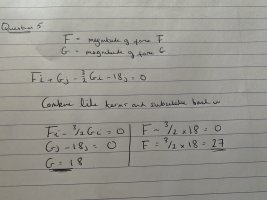mikewill54
New member
- Joined
- Mar 7, 2016
- Messages
- 31
Hi
Hoping someone can help… I’m working through some vector problems and I can’t find my notes. I’m know the magnitude formula but I’m unsure how to combine terms in the following problem. Any help is appreciated.
The magnitude F (in newtons) of a force F and the magnitude G (in newtons) of a force G satisfy the vector equation
Fi+Gj−3/2Gi-18j=0
where i and j are the Cartesian unit vectors. What is the value of F (in newtons)?
Thanks
Mike
Hoping someone can help… I’m working through some vector problems and I can’t find my notes. I’m know the magnitude formula but I’m unsure how to combine terms in the following problem. Any help is appreciated.
The magnitude F (in newtons) of a force F and the magnitude G (in newtons) of a force G satisfy the vector equation
Fi+Gj−3/2Gi-18j=0
where i and j are the Cartesian unit vectors. What is the value of F (in newtons)?
Thanks
Mike

